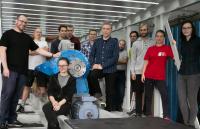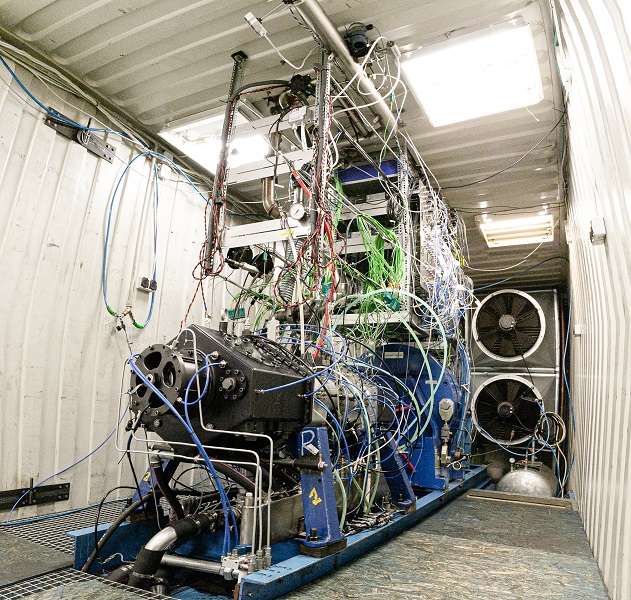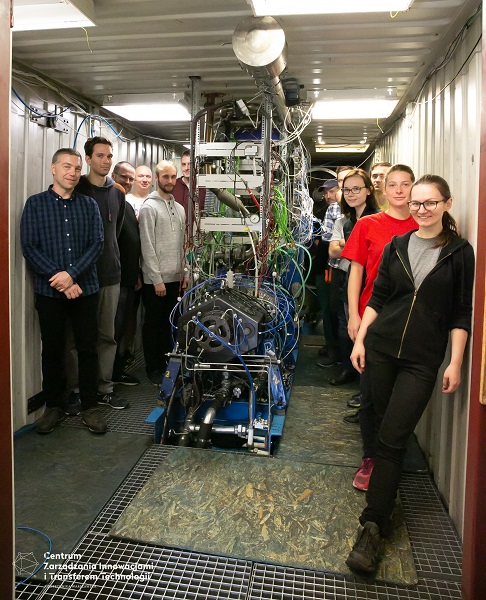Ecology and cutting-edge technology – the new engine of a WUT team
The engine uses fuel gases which have not been combusted in piston engines before. It is distinguished by its exceptionally high efficiency and therefore low CO2 emission rate. This is the engine that is being developed by researchers from the Faculty of Power and Aeronautical Engineering of the Warsaw University of Technology (WUT) and their partners from the industry.
For over 20 years, our researchers have been constructing, manufacturing and testing successive prototypes with unconventional kinematic systems, called revolvers.
“Thanks to the solutions applied in them, we obtain a relatively simple system in terms of variable compression ratio and pseudo-adiabatic combustion chambers”, explains Paweł Mazuro, PhD, Eng. from the WUT Faculty of Power and Aeronautical Engineering (MEiL). “This increases the efficiency of the engine and enables combustion of fuels with a very low net calorific value or variable physical and chemical composition.” The engines are tested on both liquid fuels and fuel gases.
PAMAR 5, the latest project, is already the fifth generation of the engine, developed by Paweł Mazuro and his team. This time, the scientists from the WUT are developing their ideas as part of the “Research on a high-performance engine using HCCI technology for application in distributed generation” project, financed by the National Centre for Research and Development.
The Warsaw University of Technology is a member of the consortium responsible for the design and research part of the project. The leader, Pimet, is active in the production of engine parts, while Horus Energia carries out in-depth analyses of the alternative fuel market.
Making good use of waste
PAMAR-5 is the most advanced of the designs created by Mazuro and his team to date. It uses systems with variable valve timing, variable compression ratios, variable phase shift angle and a system that regulates the dose of low calorific fuel gas.
“This gives the possibility of a very wide optimization of engine operation and adjusting it to fuel gases with variable properties”, Mazuro explains. “This distinguishes PAMAR 5 from engines available on the market.” These systems are being researched by engine manufacturers all over the world, but are very difficult to implement in classic designs. In revolver engines, due to their axial structure, that is not the case.
The new engine will be able to run on gases whose combustion in classic engines is very difficult — for example, gases from the gasification of biomass waste or the gasification of other waste, such as tires. This will increase the degree of waste reuse and the share of renewable energy sources (RES) in the national energy balance.
Our researchers are responding to the expectations of the distributed energy sector.
This approach is innovative not only in Poland, but also worldwide. Although the concept of revolver engines has been known since the beginning of the 20th century, such designs are wrongly considered defective. The few centres that research different types of revolver engines do not focus on use in the energy industry, but on aviation or as range extenders.
The key to success
The power of PAMAR-5 ranges from 300 kW to 1 MW, depending on the fuel used. It is a six-cylinder engine. Its characteristic feature is the parallel arrangement of the cylinder axis to the shaft axis. The reciprocating motion of the pistons is converted into rotary motion by means of a special wobble plate which is blocked by a gear train.
“Full axial symmetry in the engine concerns the kinematic system, the inlet, exhaust, power and cooling system of the engine”, explains Mazuro. “Research conducted so far shows that it may prove crucial when it comes to the possibility of optimizing and mastering the HCCI (Homogeneous Charge Compression Ignition) mode in multi-cylinder engines.”
The future belongs to HCCI engines (i.e. homogeneous charge compression ignition engines). This is the response to the challenge of combining high efficiency and drastically reducing NOx emissions.
In addition, the peripheral repeatability of the revolver engine’s geometry and the nature of its operation allow for complete and automatic balancing of the engine and a significant reduction in the vibration level. All the technical details that give the WUT team a competitive advantage have been described in the article “The Potential of Wobble Plate Opposed Piston Axial Engines for Increased Efficiency”, recently published in the prestigious “Energies” magazine. The article is available free of charge on the Internet.
A zero which means a lot
PAMAR 5 uses a counter-rotating piston system and longitudinal cylinder washing (easy to use in revolver engines, complicated in engines with classic crankshaft).
Such an arrangement results in increased volumetric efficiency and better use of engine capacity. In combination with variability systems, it also allows to control the level of exhaust gas recirculation and to obtain charge stratification, which is difficult to achieve in ordinary engines.
The overall efficiency of the PAMAR 3 engine tested in 2009 was 44%, which stands out against units of similar class produced at that time (39-41%). As expected, the PAMAR 5 engine will also successfully compete with engines available on the market in this respect. It should be noted that (thanks to the use of ultra-clean HCCI combustion technology) the revolver-type engine, designed for generator sets, will be characterized by significantly reduced emission of nitrogen oxides.
As part of the project run in collaboration with Pimet and Horus Energia, Mazuro’s team is building a test stand for a richly metered engine, with a large adjustment range. This will make it possible to determine the range of parameters of the (greatly simplified) target engine intended for low-scale production.
Lessons for the future
An engine produced in Poland would be a great success for our country. So far we have relied on drive units produced abroad or manufactured in Poland under foreign license. The use of PAMAR motors does not have to be limited to distributed generation only. Their flexible fuel capability is a desirable feature, for instance in military vehicles. The team presented the results of their work, among others, at a meeting with members of the Polish Armaments Group. The military confirmed that the engine has great potential and could be used in tracked vehicles. The PAMAR 4 prototype is already being tested in this regard.
Another direction of development may be drone motors. Unmanned aerial vehicles are gaining more and more attention and are the subject of research all over the world. Revolver engines could prove suitable to drive communication drones in the future. In aviation applications they have the advantage of the small frontal area and high power density. This was confirmed during the construction of the PAMAR 3 engine, which was developed as part of the “Construction of a 5-cylinder free-piston diesel aircraft engine with a capacity of 3000 cm3 and with cylinder axes parallel to the engine shaft axis” project carried out between 2007 and 2009.
Our researchers are open to inquiries from various industries. Further direction of development will be determined shortly after the completion of the current project. At the beginning of next year a decision should be made to start work on a commercial engine as soon as possible.
“The implementation of the engine for low-scale production would be a dream crowning to over twenty years of work”, Mazuro stated.
The “Research on a high-performance engine using HCCI technology for distributed generation applications” project financed by the National Centre for Research and Development as part of the Applied Research III Program, in Track B, in accordance with contract no. PBS3/B4/16/2015
Consortium: Pimet (leader), Warsaw University of Technology, Horus Energia
Project Lead: Paweł Mazuro, PhD, Eng.
Warsaw University of Technology team: PhD students and students of the Faculty of Power and Aeronautical Engineering of the WUT
Project duration: January 1, 2016 to December 31, 2020










